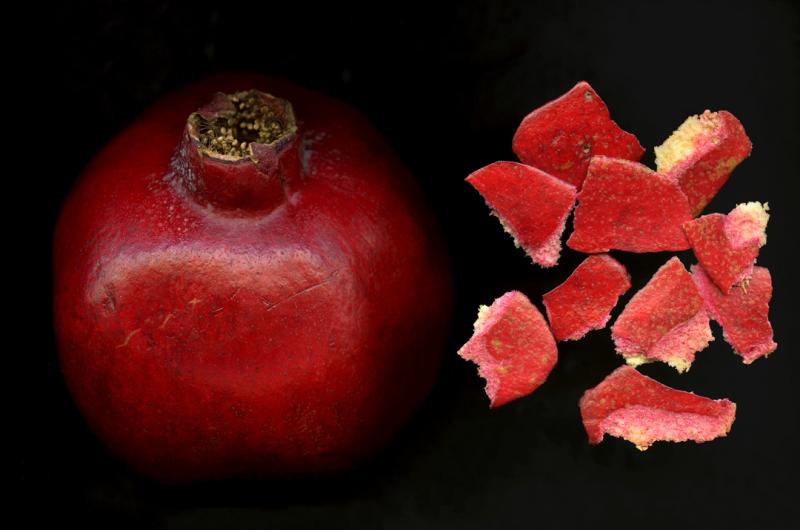Color
The art of giving textiles color is a feat of chemistry and creativity that has been passed down for millennia. You can achieve your desired hue by using a variety of natural dye sources, re-dyeing to combine colors, and experimenting with additional ingredients and water temperatures. Here are some examples of natural dyes that can produce each color of the rainbow.
Red
Red is a color prized by many cultures, and competition for the brightest and longest lasting shade shaped trade and fashion across Europe and Asia. When Spanish explorers arrived in the Americas in the 15th century, they discovered that the indigenous people used cochineal insects to make a vivid red dye. The Spaniards traded brilliant red products around the world but kept the source a secret for many years, adding considerably to their wealth.
Madder Root
People have used madder as a dye for 5,000 years. You can use this versatile root to produce a range of reds, oranges, and browns, or combine it with other dyes to make purple. Until the introduction of synthetic dyes, madder was a global source of red because it was easy to cultivate and provided a plentiful, reliable supply of dyestuff, far less expensive than insect reds. Plant fibers like cotton do not take color from madder easily, but treating them with tannins and alum before dyeing helps.
Cochineal
Cochineal insects live and feed on the prickly pear cactus commonly found in Mexico, Central and South America, and the Canary Islands. Female insects produce a powerful dye (carmine) that can be combined with various mordants to create a wide range of fuchsias, reds, and purples. Maya and Aztec peoples used cochineal as a pigment as early as 1000 BCE. It became a major global export in the 15th century when the Spanish encountered its superior dyeing properties and began trading it around the world. It is still used commercially in food dyes and cosmetics.
Brazilwood
Although its common name comes from the Brazilian variety, most brazilwood sold as a dye comes from sappanwood, an Asian species of Caesalpinia trees that yields a range of strong red dyes.
Yellow
Yellow dye comes from many sources, but it is rare to find one that creates lasting color. Often, its brilliance fades more quickly than other dyes like indigo or madder. Over time, exposure to light will cause colors in naturally dyed textiles to fade, change, or disappear altogether. Before the introduction of synthetic dyes, the weld plant produced some of the most light- and wash-fast yellow dyes.
Weld
Weld is a hardy plant that grows in Europe and other temperate climates. It is one of the oldest sources of yellow dyes. The leaves, flowers, and fruit produce excellent yellows that withstand washing and exposure to light better than other natural yellows. It is commonly combined with indigo to make various shades of green. Its popularity as a dye peaked in the European Middle Ages, when it was relied on for making greens, yellows, and oranges. Weld is still commonly used as a natural dye.
Turmeric
Turmeric is a root plant used as a culinary spice, medicinal treatment, and yellow dye for textile painting and printing.
Pomegranate
The rind of a pomegranate fruit produces a yellow dye, and the skins help improve colorfastness.
Blue
All indigo blues share the same basic chemical makeup. Even synthetic indigo is a chemical copy of indigotin, the blue-producing compound found in many plants. Only a few types of plants will produce a reliable blue, with varieties of indigo and woad being the most widely used. In addition to making blue, indigo can be combined with other dyes to produce a wide range of cool colors, as well as brown and black.
Indigo
Indigofera tinctura and a variety of related plant species can produce indigo in usable quantities. There are many methods for indigo dyeing, but in every case it is a multi-step chemical process to make the dye water-soluble and the dye vat oxygen-free. Before dyeing begins, you must treat the indigo dye vat to achieve the right pH balance. When you first remove fibers from the dye vat, they are yellow-green, but they change to blue when they come into contact with oxygen. Your fiber or cloth will get darker each time you dip it in the dye. Indigo is the only natural dye that does not require a mordant.
Woad
Woad contains the same indigotin compound as other indigo plant species, but in smaller amounts. Woad is found in more temperate climates and is distinguished by its grey-blue tones.
Synthetic Indigo
Indigo is the most commonly worn dye in the world. Even synthetic indigo is a chemical copy of indigotin, the blue-producing compound found in many plants. Have you ever noticed blue from your jeans rubbing off on your hands or furniture? Because indigo is not soluble, it does not penetrate and bind with fibers during dyeing. Instead, it is suspended among the fibers and can rub off.
Green
Although green is the most abundant color in the natural world, it is almost impossible to create a deep, vibrant green without adding ingredients or mixing dyes. Adding iron can make light hues darker, but green is most often a combination of blues and yellows dyed one after the other in a process called overdyeing.
Purple
Purple usually comes from a combination of red dyes and indigo, but a few very precious sources also produce this color. One natural source is the Murex shellfish, which secretes the deep Tyrian purple dye. It was highly sought after in the Mediterranean during Greco-Roman times and has long been associated with royalty and wealth due to its scarcity.
Logwood
Logwood comes from the inner wood of the small, gnarled logwood trees found in swampy regions of Central America and the Caribbean. After Europeans encountered it in the 15th century, logwood became a major global commodity because of its ability to produce a wide range of then-fashionable purples and blacks. While logwood purples tend to fade, the dye became a key ingredient in making affordable and colorfast blacks, a discovery that dramatically changed color preferences in Western fashion.
Murex Shellfish
Clear liquid extracted from the glands of this shellfish turns purple when exposed to light. Purple producing shellfish from the Muricidae family are found on the coasts of Mexico and the Mediterranean.
Cochineal
Cochineal insects live and feed on the prickly pear cactus commonly found in Mexico, Central and South America, and the Canary Islands. Female insects produce a powerful dye (carmine) that can be combined with various mordants to create a wide range of fuchsias, reds, and purples. Maya and Aztec peoples used cochineal as a pigment as early as 1000 BCE. It became a major global export in the 15th century when the Spanish encountered its superior dyeing properties and began trading it around the world. It is still used commercially in food dyes and cosmetics.
Brown
Brown is likely the oldest dye color to be used by humans. People discovered the dye properties of plants when cultivating them for food. Brown can also be made by mixing colors through overdyeing.
Walnuts
The fleshy part of a walnut's fruit is full of brown liquid that will stain clothes (and hands).
Henna
Henna is used to dye hair and skin as well as fibers. Its dried, ground leaves make brown and rust colors on animal fibers.





















